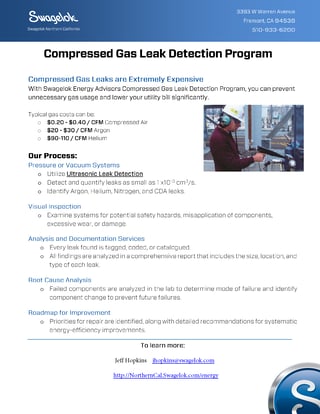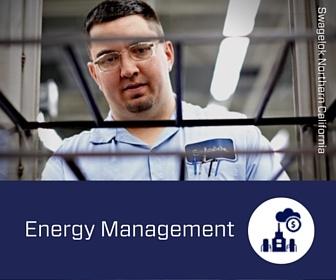Share this
Three Kinds of Leaks and How to Track Them Down
by Jeff Hopkins on 9/21/17 8:45 AM
There's no single best way, but each method has its own advantages
Learn more about the Swagelok Northern California Compressed Gas Leak Detection Program and other Energy Management Services Here >>
Real and virtual leaks and permeation
Have you priced a gallon of hydraulic fluid lately? Now think of a leak that wastes six drops of fluid per minute. That's more than 40 gallons a year in needless replacement costs. Leaks can also cause safety issues, ruin equipment and knock you off schedule. It's worth the time and effort to find those leaks and deal with them.
When we think of fluid leaks, we usually picture a real leak caused by cracks, gaps between sealing surfaces, or permeation through seal materials. Basically, this category covers any time a pressure barrier fails to contain or isolate a system fluid from the surrounding environment.
But a system also can have virtual leaks, which release internally trapped fluid into a fluid system due to material outgassing (escape of gas from a material under test in a vacuum), absorbed or adsorbed fluids, entrapment in cracks, or deadlegs.
There's also permeation, the passage of fluid into, through, and out of a pressure barrier having no holes large enough to permit more than a small fraction of the molecules to pass through any one hole.
How to find the three kinds of leaks
There are several ways to find a leak, each with its own set of advantages and disadvantages.
Bubble test
Bubble Testing is fast, simple and inexpensive test uses immersion or a film solution. The unit being tested is pressurized to create a pressure differential, and any leaks create bubbles in the solution. It's a fairly sensitive test, and allows you to evaluate an entire component at once. If you know there's a leak but haven't discovered whether it's real or virtual, this test can tell you. On the downside, smaller leaks are harder to detect, you won't be able to measure the specific leak rate, and the unit you are testing will have to be cleaned or dried when you are done.
It's worth the time and effort to find those leaks and deal with them.
Pressure leak testing
Pressure Leak Testing is an excellent proof test that is best for leak location. The two techniques for best results are hydrostatic and pneumatic tests. The unit under test is gradually pressurized with water or air to a specified mark and held for a set length of time. Pressure is then reduced to design pressure and the unit is observed for leakage. Like Bubble Testing, it's inexpensive, simple and clean, and you can evaluate the entire assembly at once. On the other hand, it's a slow test, and it might even be dangerous if air is not completely evacuated from the assembly. Once again, assemblies must be cleaned and dried following testing.
Pressure Change Measurement Testing
Pressure Change Measurement Testing determines total leakage. It looks a change in pressure across a pressure boundary caused by leakage. A decrease in pressure indicates leakage. The leak rate can then be calculated and evaluated to see whether it is within acceptable limits. The four common techniques for this test are pressure decay, pressure change absolute, pressure change reference, and volume or flow measurement. Pressure decay is the most commonly used technique, but it is best for small systems with volumes less than 7.5 cubic feet. The big advantage with this test is that you can determine total leakage. It requires no special tracer gas, and works in small-volume applications. But with this test you must already know the internal volume. This test can't locate leaks, and it can be less sensitive in large-volume applications.
Mass Spectrometry Testing
Mass Spectrometry Testing is a versatile, reliable method of both measuring leakage and locating leaks. A mass spectrometer is used to measure the amount of tracer gas, usually helium, in the unit being tested. This is done by creating a pressure differential between the mass spectrometer and the unit being tested. The presence of the tracer gas inside the mass spectrometer indicates a leak. There are actually different five techniques for this test, using a hood, a tracer probe, a detector probe, accumulation, and a bell jar. With this test, you can measure a great degree of reliability and sensitivity. You can both measure leakage and locate leaks. But this test does require a skilled operator and a comprehensive test plan when used on large or complex systems. The equipment is also expensive and costly to repair.
Which method should you start with? Talk to us and we can help you decide. We're standing by at 510-933-6200, or you can reach us through our website.
additional resources
get in touch
In a hurry or have a question? Please click here to get in touch - we respond fast! Or call 510-933-6200.
Share this
- Archive (465)
- Assembly Services (207)
- About (100)
- Seal Support Systems (96)
- Best Practices (88)
- Training Services (74)
- Fittings (51)
- Semiconductor Applications (49)
- Hoses and Flexible Tubing (47)
- Regulators (44)
- Tubing (42)
- Grab Sampling Systems (32)
- Sampling Systems (32)
- Gas Systems (30)
- Services (30)
- Downloads (29)
- Valves (24)
- Application Support (18)
- Orbital Welding (17)
- Case Studies (13)
- Steam Systems (13)
- Frequently Asked Questions (12)
- Tools (12)
- Measurement Devices (7)
- Subsystems (6)
- Thermal Management (6)
- September 2023 (1)
- August 2023 (2)
- June 2023 (1)
- March 2023 (3)
- February 2023 (3)
- January 2023 (4)
- December 2022 (4)
- November 2022 (4)
- October 2022 (4)
- September 2022 (1)
- August 2022 (3)
- July 2022 (2)
- June 2022 (4)
- May 2022 (1)
- April 2022 (2)
- March 2022 (1)
- February 2022 (2)
- January 2022 (3)
- December 2021 (1)
- November 2021 (6)
- October 2021 (6)
- September 2021 (8)
- August 2021 (4)
- July 2021 (3)
- June 2021 (6)
- May 2021 (6)
- April 2021 (7)
- March 2021 (5)
- February 2021 (4)
- January 2021 (6)
- December 2020 (5)
- November 2020 (6)
- October 2020 (6)
- September 2020 (8)
- August 2020 (7)
- July 2020 (8)
- June 2020 (8)
- May 2020 (6)
- April 2020 (9)
- March 2020 (7)
- February 2020 (10)
- January 2020 (21)
- December 2019 (23)
- November 2019 (21)
- October 2019 (22)
- September 2019 (21)
- August 2019 (22)
- July 2019 (23)
- June 2019 (20)
- May 2019 (23)
- April 2019 (22)
- March 2019 (21)
- February 2019 (20)
- January 2019 (21)
- December 2018 (14)
- November 2018 (19)
- October 2018 (23)
- September 2018 (17)
- August 2018 (29)
- July 2018 (11)
- June 2018 (6)
- May 2018 (5)
- April 2018 (4)
- March 2018 (5)
- February 2018 (3)
- January 2018 (3)
- December 2017 (2)
- November 2017 (4)
- October 2017 (3)
- September 2017 (2)
- August 2017 (6)
- July 2017 (4)
- June 2017 (4)
- May 2017 (4)
- April 2017 (3)
- March 2017 (4)
- February 2017 (3)
- January 2017 (3)
- December 2016 (3)
- November 2016 (3)
- October 2016 (3)
- September 2016 (5)
- August 2016 (5)
- July 2016 (4)
- June 2016 (5)
- May 2016 (3)
- April 2016 (4)
- March 2016 (5)
- February 2016 (11)
- January 2016 (1)
- December 2015 (3)
- November 2015 (4)
- October 2015 (3)
- September 2015 (4)
- August 2015 (4)
- July 2015 (8)
- June 2015 (5)
- May 2015 (3)
- April 2015 (4)
- March 2015 (4)
- February 2015 (3)
- January 2015 (4)
- December 2014 (2)
- November 2014 (3)
- October 2014 (4)
- September 2014 (4)
- August 2014 (4)
- July 2014 (5)
- June 2014 (4)
- May 2014 (4)
- April 2014 (5)
- March 2014 (4)
- February 2014 (3)
- January 2014 (4)
- December 2013 (5)
- November 2013 (3)
- October 2013 (4)
- September 2013 (3)
- August 2013 (5)
- July 2013 (5)
- June 2013 (5)
- May 2013 (3)
- April 2013 (6)
- March 2013 (4)
- February 2013 (4)
- January 2013 (8)
- December 2012 (4)
- November 2012 (6)
- October 2012 (6)
- September 2012 (4)
- August 2012 (4)
- July 2012 (4)
- June 2012 (4)

.webp?width=210&height=70&name=StickyLogo%20(5).webp)


